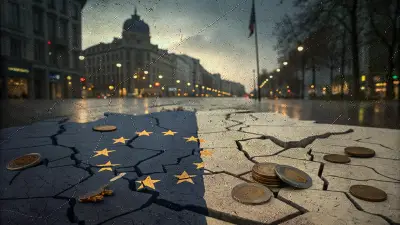
The economic situation in Europe is currently facing a serious crisis. As of January 2025, Europe’s economic crisis and loss of competitiveness remains unresolved.
The $14 billion fine imposed on Apple by the European Union last year is more than just a tax dispute; it is an example of the fundamental challenges and contradictions facing the modern European economy. Why did this nearly two-decade-long legal battle begin, and what does it mean for the future of Europe?
“We tried to regulate big tech and ended up becoming more dependent on them.”
These words from a senior European official pinpoint the dilemma Europe is currently facing.
European big tech regulation: unintended consequences
The European Union (EU) has long sought to regulate U.S. big tech companies. One of the results is the $14 billion fine against Apple, which was finalized because the company received illegal tax benefits in Ireland. At first glance, this seems like a victory for the EU, but it’s not.
The ruling caused Apple’s stock price to drop 1%, which translates to a loss of $40 billion in market capitalization. But Apple’s shareholders didn’t have much of a reaction to this.
Why? Because that’s only a month and a half’s worth of operating income for Apple.
Ireland’s dilemma: Walking the tightrope between taxes and economic development
The position of Ireland, another protagonist in this case, is also interesting. Ireland is owed $14 billion from Apple, but it’s trying to avoid taking it. Why?
Ireland has attracted global companies by keeping its corporate tax rate low at 12.5%, which has been a driver of job creation and economic growth. But the EU’s ruling threatens that tax strategy. “We’ve done nothing but run a legitimate tax policy, and we’re concerned that this ruling will have a negative impact on our ability to attract global companies in the future,” said an Irish government official.
While Apple’s tax dispute with Ireland may have appeared on the surface to be a simple matter of tax avoidance, it actually exposed deeper issues of Europe’s inability to digitally innovate, fragmented market structures, and lack of integrated economic policy.
From an economic perspective, Europe’s current situation is a classic case of ‘Institutional Path Dependency’. The successful institutions and policies of the past have become stumbling blocks that prevent adaptation to new environmental changes.
Europe’s competitiveness crisis: The cost of big tech absence
The EU’s big tech regulation has had an unintended consequence: in the absence of Europe’s own big tech companies, it has increased its reliance on U.S. firms. With the exception of SAP, Europe is home to few global-level big tech companies, leading to a serious competitiveness crisis.
A recent report by former European Central Bank (ECB) President Mario Draghi clearly points to this problem. “There is a clear productivity slowdown in Europe, which is leading to a decline in the quality of life of individuals,” he warned.
Causes of Europe’s loss of competitiveness
- Regulatory paradox: While purportedly encouraging innovation, disparate national regulations have prevented companies from acting in a unified way.
- Fragmented markets: The EU is supposed to be an economic community, but in reality, it’s 27 countries going it alone.
- Lack of investment: Europe receives only 5% of the world’s startup investment. This compares to 52% in the US.
- R&D-commercialization gap: Europe’s R&D capabilities remain strong, but its commercialization rate lags far behind the US. The solution: massive investment and an integrated approach To address these issues, Draghi has proposed a massive investment of €120 billion per year, which is equivalent to 4.5% of the EU’s GDP. To put it in historical perspective, this is a scale that surpasses the Marshall Plan.
But this proposal faces a major hurdle. It’s opposition from EU member states. Germany, in particular, is strongly opposed to joint debt issuance. “We can’t take on other countries’ debts – each country has to do its own economic reforms,” said a German finance ministry official.
Economic analysis: Europe’s dilemma
The current situation in Europe can be explained by several theories in economics.
- Path Dependence: Europe is stuck in a model of past success. Its manufacturing-oriented economy has become obsolete in the digital age.
- Network Effects: The success of big tech companies is due to network effects. As Europe lags behind in this area, the gap is widening.
- Economies of Scale: Compared to the US and China, with their integrated mega-markets, the fragmented European market has difficulty realizing economies of scale.
- Institutional Isomorphism: EU member states tend to adopt similar institutions to each other, which can stifle innovation.
- Tragedy’s of the Commons: While investments should be made for the common good of the EU, countries tend to look out for their own interests.
Recommendations for the future
To regain its competitiveness, Europe should consider the following measures
- Building a unified digital marketplace: The 27 countries’ disparate regulations need to be harmonized to make it easier for companies to scale.
- Strengthening the venture capital ecosystem: A government-led fund should be created to stimulate investment in startups.
- Reform the education system: The curriculum needs to be overhauled to create a workforce fit for the digital age.
- Introduce a regulatory sandbox: We need to create an environment where innovative companies can test new ideas without regulatory constraints.
- Expand joint R&D projects: We need to strengthen cooperation between member states through large-scale EU-wide research projects.
Conclusion: A critical juncture, how to invest?
Seize the opportunities in the European market
- Focus on undervalued sectors: European equity markets are currently relatively undervalued, offering attractive investment opportunities. The price-to-earnings (P/E) ratio of the STOXX600 is approximately 49% lower than that of the S&P500, making it quite attractive from a valuation perspective. German stocks are particularly attractive, with the DAX index constituents trading at 13.4x P/E, a 42% discount to the US.
- Consider investing in small and mid-cap stocks: European small and mid-cap companies trade at a wider discount to their larger counterparts and are potential targets for increased merger and acquisition (M&A) activity.
- Watch for growth in southern European countries: Southern European countries such as Spain, Portugal, and Greece are showing stronger resilience than northern European countries due to growing service industries, high immigration rates, and recovery fund investments.
- Opportunities for exporters: A weaker euro could create new opportunities for European exporters. With exports accounting for more than 50% of the eurozone economy, exchange rate effects can offset the negative impact of tariffs6. German companies in particular are performing well despite the slowdown at home due to the high proportion of their sales coming from abroad, especially the U.S.
*This represents an average, not all European countries. These figures vary depending on time and circumstances.*
Investing in technology and innovation
- Explore AI-related companies: Europe also has AI-related “shovel and pickaxe” companies, such as semiconductor equipment companies and data center infrastructure providers, which could benefit from the AI boom.
- Keep an eye on digital transformation companies: European “old economy” companies that succeed in decarbonizing and digitizing could have great growth potential
- Look for innovative startups: Europe’s startup ecosystem is small compared to the U.S., but it has great potential for growth, especially in the fintech, healthtech, and greentech sectors. Prepare for changes in the regulatory environment
- Monitor the impact of big tech regulations: Keep an eye on market changes as big tech regulations, such as the EU’s Digital Markets Act (DMA), come into effect, which could create new opportunities for European companies.
- Strengthen ESG investing: Europe is strengthening its ESG regulations, which will become an increasingly important factor in company valuations Consider investing in companies that meet ESG criteria.
- Focus on energy transition companies: Europe’s energy transition policies are likely to drive growth in renewable energy, energy efficiency, and smart grid companies.
Investing should be approached cautiously, keeping an eye on the pace of Europe’s economic recovery, the changing regulatory environment, and global geopolitical risks, while also recognizing opportunities arising from undervalued assets, innovative companies, and structural changes such as the energy transition.




